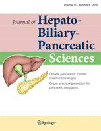Portal hemodynamics and clinical outcomes of patients with gastric varices after balloon-occluded retrograde transvenous obliteration
Abstract
Background
Long-term hemodynamic effects and clinical outcomes after balloon-occluded retrograde transvenous obliteration (B-RTO) remain unclear. The purpose of this study was to evaluate long-term clinical results and effects on portal hemodynamics after B-RTO for the treatment of gastric varices with spontaneous gastrorenal shunt.
Methods
A total of 21 patients with cirrhosis and gastric varices treated by B-RTO were evaluated. The cumulative survival rate was calculated, portal blood flow was measured by Doppler ultrasonography, and liver function was estimated on the basis of Child-Pugh classification before and 1 year after B-RTO.
Results
Gastric varices disappeared or decreased markedly in size in all patients. Overall cumulative survival rates at 1, 3 and 5 years were 90.48, 71.11 and 53.71%, respectively. Portal blood flow increased significantly from 681.9 ± 294.9 to 837.0 ± 279.1 ml/min (p = 0.0125) after B-RTO. Child-Pugh score was not significantly changed (p = 0.755) after obliteration, but serum albumin was elevated significantly from 3.49 ± 0.49 to 3.75 ± 0.53 g/dl (p = 0.0459). The ascites score was significantly increased (p = 0.0455) after B-RTO, but all cases of ascites could be controlled with medication.
Conclusions
Balloon-occluded retrograde transvenous obliteration is a safe and effective treatment for gastric varices with gastrorenal shunt. Portal blood flow and serum albumin parameters are increased, and liver function is unchanged after B-RTO.




